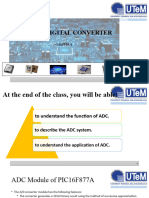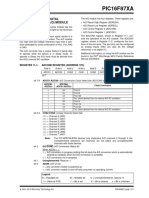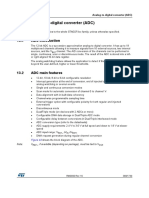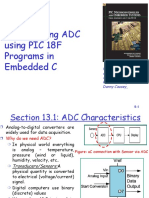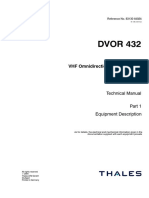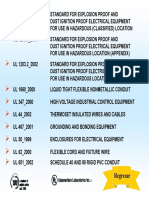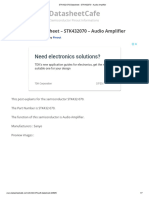PIC16F/LF1826/27
14.0
FIXED VOLTAGE REFERENCE
(FVR)
14.1
Independent Gain Amplifiers
The Fixed Voltage Reference, or FVR, is a stable
voltage reference, independent of VDD, with 1.024V,
2.048V or 4.096V selectable output levels. The output
of the FVR can be configured to supply a reference
voltage to the following:
The output of the FVR supplied to the ADC,
Comparators, and DAC is routed through two
independent programmable gain amplifiers. Each
amplifier can be configured to amplify the reference
voltage by 1x, 2x or 4x, to produce the three possible
voltage levels.
The ADFVR<1:0> bits of the FVRCON register are
used to enable and configure the gain amplifier settings
for the reference supplied to the ADC module. Reference Section 15.0 Analog-to-Digital Converter
(ADC) Module for additional information.
ADC input channel
ADC positive reference
Comparator positive input
Digital-to-Analog Converter (DAC)
The FVR can be enabled by setting the FVREN bit of
the FVRCON register.
The CDAFVR<1:0> bits of the FVRCON register are
used to enable and configure the gain amplifier settings
for the reference supplied to the DAC and comparator
module. Reference Section 16.0 Digital-to-Analog
Converter (DAC) Module and Section 17.0 Comparator Module for additional information.
14.2
FVR Stabilization Period
When the Fixed Voltage Reference module is enabled, it
requires time for the reference and amplifier circuits to
stabilize. Once the circuits stabilize and are ready for use,
the FVRRDY bit of the FVRCON register will be set. See
Section 29.0 Electrical Specifications for the
minimum delay requirement.
FIGURE 14-1:
VOLTAGE REFERENCE BLOCK DIAGRAM
ADFVR<1:0>
CDAFVR<1:0>
FVREN
FVRRDY
2009 Microchip Technology Inc.
2
X1
X2
X4
FVR BUFFER1
(To ADC Module)
X1
X2
X4
FVR BUFFER2
(To Comparators, DAC)
+
_
1.024V Fixed
Reference
Preliminary
DS41391B-page 135
�PIC16F/LF1826/27
REGISTER 14-1:
FVRCON: FIXED VOLTAGE REFERENCE CONTROL REGISTER
R/W-0/0
R-q/q
R/W-0/0
R/W-0/0
R/W-0/0
R/W-0/0
R/W-0/0
R/W-0/0
FVREN
FVRRDY(1)
Reserved
Reserved
CDAFVR1
CDAFVR0
ADFVR1
ADFVR0
bit 7
bit 0
Legend:
R = Readable bit
W = Writable bit
U = Unimplemented bit, read as 0
u = Bit is unchanged
x = Bit is unknown
-n/n = Value at POR and BOR/Value at all other Resets
1 = Bit is set
0 = Bit is cleared
q = Value depends on condition
bit 7
FVREN: Fixed Voltage Reference Enable bit
0 = Fixed Voltage Reference is disabled
1 = Fixed Voltage Reference is enabled
bit 6
FVRRDY: Fixed Voltage Reference Ready Flag bit(1)
0 = Fixed Voltage Reference output is not ready or not enabled
1 = Fixed Voltage Reference output is ready for use
bit 5-4
Reserved: Read as 0. Maintain these bits clear.
bit 3-2
CDAFVR<1:0>: Comparator and DAC Fixed Voltage Reference Selection bit
00 = Comparator and DAC Fixed Voltage Reference Peripheral output is off.
01 = Comparator and DAC Fixed Voltage Reference Peripheral output is 1x (1.024V)
10 = Comparator and DAC Fixed Voltage Reference Peripheral output is 2x (2.048V)(2)
11 = Comparator and DAC Fixed Voltage Reference Peripheral output is 4x (4.096V)(2)
bit 1-0
ADFVR<1:0>: ADC Fixed Voltage Reference Selection bit
00 = ADC Fixed Voltage Reference Peripheral output is off.
01 = ADC Fixed Voltage Reference Peripheral output is 1x (1.024V)
10 = ADC Fixed Voltage Reference Peripheral output is 2x (2.048V)(2)
11 = ADC Fixed Voltage Reference Peripheral output is 4x (4.096V)(2)
Note 1:
2:
FVRRDY is always 1 on devices with the LDO (PIC16F1826/27).
Fixed Voltage Reference output cannot exceed VDD.
TABLE 14-1:
Name
FVRCON
Legend:
SUMMARY OF REGISTERS ASSOCIATED WITH THE FVR MODULE
Bit 7
Bit 6
Bit 5
Bit 4
Bit 3
Bit 2
Bit 1
Bit 0
Register
on page
FVREN
FVRRDY
Reserved
Reserved
CDAFVR1
CDAFVR0
ADFVR1
ADFVR0
136
Shaded cells are unused by the FVR module.
DS41391B-page 136
Preliminary
2009 Microchip Technology Inc.
�PIC16F/LF1826/27
15.0
The ADC can generate an interrupt upon completion of
a conversion. This interrupt can be used to wake-up the
device from Sleep.
ANALOG-TO-DIGITAL
CONVERTER (ADC) MODULE
The Analog-to-Digital Converter (ADC) allows
conversion of an analog input signal to a 10-bit binary
representation of that signal. This device uses analog
inputs, which are multiplexed into a single sample and
hold circuit. The output of the sample and hold is
connected to the input of the converter. The converter
generates a 10-bit binary result via successive
approximation and stores the conversion result into the
ADC result register (ADRES). Figure 15-1 shows the
block diagram of the ADC.
The ADC voltage reference is software selectable to be
either internally generated or externally supplied.
FIGURE 15-1:
ADC BLOCK DIAGRAM
ADNREF = 1
VREF-
ADNREF = 0
VDD
VSS
ADPREF = 0X
ADPREF = 11
VREF+
AN0
00000
AN1
00001
AN2
00010
AN3
00011
AN4
00100
AN5
00101
AN6
00110
AN7
00111
AN8
01000
AN9
01001
AN10
01010
AN11
01011
DAC
11110
FVR Buffer1
11111
ADPREF = 10
ADC
10
GO/DONE
ADFM
0 = Left Justify
1 = Right Justify
16
ADON
VSS
ADRESH
ADRESL
CHS<4:0>
Note:
When ADON = 0, all multiplexer inputs are disconnected.
2009 Microchip Technology Inc.
Preliminary
DS41391B-page 137
�PIC16F/LF1826/27
15.1
15.1.4
ADC Configuration
When configuring and using the ADC the following
functions must be considered:
Port configuration
Channel selection
ADC voltage reference selection
ADC conversion clock source
Interrupt control
Result formatting
15.1.1
The ADC can be used to convert both analog and
digital signals. When converting analog signals, the I/O
pin should be configured for analog by setting the
associated TRIS and ANSEL bits. Refer to
Section 12.0 I/O Ports for more information.
Note:
15.1.2
The source of the conversion clock is software selectable via the ADCS bits of the ADCON1 register. There
are seven possible clock options:
PORT CONFIGURATION
Analog voltages on any pin that is defined
as a digital input may cause the input buffer to conduct excess current.
FOSC/2
FOSC/4
FOSC/8
FOSC/16
FOSC/32
FOSC/64
FRC (dedicated internal oscillator)
The time to complete one bit conversion is defined as
TAD. One full 10-bit conversion requires 11.5 TAD periods as shown in Figure 15-2.
For correct conversion, the appropriate TAD specification must be met. Refer to the A/D conversion requirements in Section 29.0 Electrical Specifications for
more information. Table 15-1 gives examples of appropriate ADC clock selections.
Note:
CHANNEL SELECTION
CONVERSION CLOCK
There are 14 channel selections available:
AN<11:0> pins
DAC Output
FVR (Fixed Voltage Reference) Output
Unless using the FRC, any changes in the
system clock frequency will change the
ADC clock frequency, which may
adversely affect the ADC result.
Refer to Section 16.0 Digital-to-Analog Converter
(DAC) Module and Section 14.0 Fixed Voltage
Reference (FVR) for more information on these channel selections.
The CHS bits of the ADCON0 register determine which
channel is connected to the sample and hold circuit.
When changing channels, a delay is required before
starting the next conversion. Refer to Section 15.2
ADC Operation for more information.
15.1.3
ADC VOLTAGE REFERENCE
The ADPREF bits of the ADCON1 register provides
control of the positive voltage reference. The positive
voltage reference can be:
VREF+ pin
VDD
FVR
The ADNREF bits of the ADCON1 register provides
control of the negative voltage reference. The negative
voltage reference can be:
VREF- pin
VSS
See Section 14.0 Fixed Voltage Reference (FVR)
for more details on the fixed voltage reference.
DS41391B-page 138
Preliminary
2009 Microchip Technology Inc.
�PIC16F/LF1826/27
TABLE 15-1:
ADC CLOCK PERIOD (TAD) VS. DEVICE OPERATING FREQUENCIES
Device Frequency (FOSC)
Device Frequency (FOSC)
ADC Clock Period (TAD)
ADC
Clock Source
ADCS<2:0>
32 MHz
20 MHz
16 MHz
8 MHz
4 MHz
1 MHz
Fosc/2
000
62.5ns(2)
100 ns(2)
125 ns(2)
250 ns(2)
500 ns(2)
2.0 s
Fosc/4
100
125 ns
(2)
(2)
(2)
(2)
1.0 s
4.0 s
Fosc/8
001
0.5 s(2)
400 ns(2)
0.5 s(2)
1.0 s
2.0 s
8.0 s(3)
Fosc/16
101
800 ns
800 ns
1.0 s
2.0 s
4.0 s
16.0 s(3)
Fosc/32
010
1.0 s
1.6 s
2.0 s
4.0 s
8.0 s(3)
32.0 s(3)
s(3)
64.0 s(3)
Fosc/64
FRC
Legend:
Note 1:
2:
3:
4:
2.0 s
110
x11
1.0-6.0 s
200 ns
3.2 s
(1,4)
1.0-6.0 s
250 ns
4.0 s
(1,4)
1.0-6.0 s
500 ns
8.0
(1,4)
s(3)
1.0-6.0 s
(1,4)
16.0
1.0-6.0 s
(1,4)
1.0-6.0 s(1,4)
Shaded cells are outside of recommended range.
The FRC source has a typical TAD time of 1.6 s for VDD.
These values violate the minimum required TAD time.
For faster conversion times, the selection of another clock source is recommended.
When the device frequency is greater than 1 MHz, the FRC clock source is only recommended if the conversion will be
performed during Sleep.
FIGURE 15-2:
ANALOG-TO-DIGITAL CONVERSION TAD CYCLES
TCY - TAD TAD1 TAD2 TAD3 TAD4 TAD5 TAD6 TAD7 TAD8 TAD9 TAD10 TAD11
b4
b1
b0
b6
b7
b2
b9
b8
b3
b5
Conversion starts
Holding capacitor is disconnected from analog input (typically 100 ns)
Set GO bit
On the following cycle:
ADRESH:ADRESL is loaded, GO bit is cleared,
ADIF bit is set, holding capacitor is connected to analog input.
2009 Microchip Technology Inc.
Preliminary
DS41391B-page 139
�PIC16F/LF1826/27
15.1.5
INTERRUPTS
15.1.6
The ADC module allows for the ability to generate an
interrupt upon completion of an Analog-to-Digital
conversion. The ADC Interrupt Flag is the ADIF bit in
the PIR1 register. The ADC Interrupt Enable is the
ADIE bit in the PIE1 register. The ADIF bit must be
cleared in software.
RESULT FORMATTING
The 10-bit A/D conversion result can be supplied in two
formats, left justified or right justified. The ADFM bit of
the ADCON1 register controls the output format.
Figure 15-3 shows the two output formats.
Note 1: The ADIF bit is set at the completion of
every conversion, regardless of whether
or not the ADC interrupt is enabled.
2: The ADC operates during Sleep only
when the FRC oscillator is selected.
This interrupt can be generated while the device is
operating or while in Sleep. If the device is in Sleep, the
interrupt will wake-up the device. Upon waking from
Sleep, the next instruction following the SLEEP instruction is always executed. If the user is attempting to
wake-up from Sleep and resume in-line code execution, the GIE and PEIE bits of the INTCON register
must be disabled. If the GIE and PEIE bits of the
INTCON register are enabled, execution will switch to
the Interrupt Service Routine.
Please refer to Section 8.0 Interrupts for more
information.
FIGURE 15-3:
10-BIT A/D CONVERSION RESULT FORMAT
ADRESH
(ADFM = 0)
ADRESL
MSB
LSB
bit 7
bit 0
bit 7
10-bit A/D Result
(ADFM = 1)
Unimplemented: Read as 0
MSB
bit 7
LSB
bit 0
Unimplemented: Read as 0
DS41391B-page 140
bit 0
bit 7
bit 0
10-bit A/D Result
Preliminary
2009 Microchip Technology Inc.
�PIC16F/LF1826/27
15.2
15.2.1
15.2.4
ADC Operation
STARTING A CONVERSION
To enable the ADC module, the ADON bit of the
ADCON0 register must be set to a 1. Setting the GO/
DONE bit of the ADCON0 register to a 1 will start the
Analog-to-Digital conversion.
Note:
15.2.2
The GO/DONE bit should not be set in the
same instruction that turns on the ADC.
Refer to Section 15.2.6 A/D Conversion Procedure.
COMPLETION OF A CONVERSION
When the conversion is complete, the ADC module will:
Clear the GO/DONE bit
Set the ADIF Interrupt Flag bit
Update the ADRESH and ADRESL registers with
new conversion result
15.2.3
TERMINATING A CONVERSION
If a conversion must be terminated before completion,
the GO/DONE bit can be cleared in software. The
ADRESH and ADRESL registers will be updated with
the partially complete Analog-to-Digital conversion
sample. Incomplete bits will match the last bit
converted.
Note:
A device Reset forces all registers to their
Reset state. Thus, the ADC module is
turned off and any pending conversion is
terminated.
ADC OPERATION DURING SLEEP
The ADC module can operate during Sleep. This
requires the ADC clock source to be set to the FRC
option. When the FRC clock source is selected, the
ADC waits one additional instruction before starting the
conversion. This allows the SLEEP instruction to be
executed, which can reduce system noise during the
conversion. If the ADC interrupt is enabled, the device
will wake-up from Sleep when the conversion
completes. If the ADC interrupt is disabled, the ADC
module is turned off after the conversion completes,
although the ADON bit remains set.
When the ADC clock source is something other than
FRC, a SLEEP instruction causes the present conversion to be aborted and the ADC module is turned off,
although the ADON bit remains set.
15.2.5
SPECIAL EVENT TRIGGER
The Special Event Trigger of the CCPx/ECCPX module
allows periodic ADC measurements without software
intervention. When this trigger occurs, the GO/DONE
bit is set by hardware and the Timer1 counter resets to
zero.
TABLE 15-2:
SPECIAL EVENT TRIGGER
Device
CCPx/ECCPx
PIC16F/LF1826
ECCP1
PIC16F/LF1827
CCP4
Using the Special Event Trigger does not assure proper
ADC timing. It is the users responsibility to ensure that
the ADC timing requirements are met.
Refer to Section 23.0 Capture/Compare/PWM Modules (ECCP1, ECCP2, CCP3, CCP4) for more
information.
2009 Microchip Technology Inc.
Preliminary
DS41391B-page 141
�PIC16F/LF1826/27
15.2.6
A/D CONVERSION PROCEDURE
EXAMPLE 15-1:
This is an example procedure for using the ADC to
perform an Analog-to-Digital conversion:
1.
2.
3.
4.
5.
6.
7.
8.
Configure Port:
Disable pin output driver (Refer to the TRIS
register)
Configure pin as analog (Refer to the ANSEL
register)
Configure the ADC module:
Select ADC conversion clock
Configure voltage reference
Select ADC input channel
Turn on ADC module
Configure ADC interrupt (optional):
Clear ADC interrupt flag
Enable ADC interrupt
Enable peripheral interrupt
Enable global interrupt(1)
Wait the required acquisition time(2).
Start conversion by setting the GO/DONE bit.
Wait for ADC conversion to complete by one of
the following:
Polling the GO/DONE bit
Waiting for the ADC interrupt (interrupts
enabled)
Read ADC Result.
Clear the ADC interrupt flag (required if interrupt
is enabled).
A/D CONVERSION
;This code block configures the ADC
;for polling, Vdd and Vss references, Frc
;clock and AN0 input.
;
;Conversion start & polling for completion
; are included.
;
BANKSEL
ADCON1
;
MOVLW
B11110000 ;Right justify, Frc
;clock
MOVWF
ADCON1
;Vdd and Vss Vref
BANKSEL
TRISA
;
BSF
TRISA,0
;Set RA0 to input
BANKSEL
ANSEL
;
BSF
ANSEL,0
;Set RA0 to analog
BANKSEL
ADCON0
;
MOVLW
B00000001 ;Select channel AN0
MOVWF
ADCON0
;Turn ADC On
CALL
SampleTime
;Acquisiton delay
BSF
ADCON0,ADGO ;Start conversion
BTFSC
ADCON0,ADGO ;Is conversion done?
GOTO
$-1
;No, test again
BANKSEL
ADRESH
;
MOVF
ADRESH,W
;Read upper 2 bits
MOVWF
RESULTHI
;store in GPR space
BANKSEL
ADRESL
;
MOVF
ADRESL,W
;Read lower 8 bits
MOVWF
RESULTLO
;Store in GPR space
Note 1: The global interrupt can be disabled if the
user is attempting to wake-up from Sleep
and resume in-line code execution.
2: Refer to Section 15.3 A/D Acquisition
Requirements.
DS41391B-page 142
Preliminary
2009 Microchip Technology Inc.
�PIC16F/LF1826/27
15.2.7
ADC REGISTER DEFINITIONS
The following registers are used to control the
operation of the ADC.
REGISTER 15-1:
ADCON0: A/D CONTROL REGISTER 0
U-0
R/W-0/0
R/W-0/0
R/W-0/0
R/W-0/0
R/W-0/0
R/W-0/0
R/W-0/0
CHS4
CHS3
CHS2
CHS1
CHS0
GO/DONE
ADON
bit 7
bit 0
Legend:
R = Readable bit
W = Writable bit
U = Unimplemented bit, read as 0
u = Bit is unchanged
x = Bit is unknown
-n/n = Value at POR and BOR/Value at all other Resets
1 = Bit is set
0 = Bit is cleared
bit 7
Unimplemented: Read as 0
bit 6-2
CHS<4:0>: Analog Channel Select bits
00000 = AN0
00001 = AN1
00010 = AN2
00011 = AN3
00100 = AN4
00101 = AN5
00110 = AN6
00111 = AN7
01000 = AN8
01001 = AN9
01010 = AN10
01011 = AN11
01100 = Reserved. No channel connected.
11101 = Reserved. No channel connected.
11110 = DAC output(1)
11111 = FVR (Fixed Voltage Reference) Buffer 1 Output(2)
bit 1
GO/DONE: A/D Conversion Status bit
1 = A/D conversion cycle in progress. Setting this bit starts an A/D conversion cycle.
This bit is automatically cleared by hardware when the A/D conversion has completed.
0 = A/D conversion completed/not in progress
bit 0
ADON: ADC Enable bit
1 = ADC is enabled
0 = ADC is disabled and consumes no operating current
Note 1:
2:
See Section 16.0 Digital-to-Analog Converter (DAC) Module for more information.
See Section 14.0 Fixed Voltage Reference (FVR) for more information.
2009 Microchip Technology Inc.
Preliminary
DS41391B-page 143
�PIC16F/LF1826/27
REGISTER 15-2:
ADCON1: A/D CONTROL REGISTER 1
R/W-0/0
R/W-0/0
R/W-0/0
R/W-0/0
U-0
R/W-0/0
R/W-0/0
R/W-0/0
ADFM
ADCS2
ADCS1
ADCS0
ADNREF
ADPREF1
ADPREF0
bit 7
bit 0
Legend:
R = Readable bit
W = Writable bit
U = Unimplemented bit, read as 0
u = Bit is unchanged
x = Bit is unknown
-n/n = Value at POR and BOR/Value at all other Resets
1 = Bit is set
0 = Bit is cleared
bit 7
ADFM: A/D Result Format Select bit
1 = Right justified. Six Most Significant bits of ADRESH are set to 0 when the conversion result is
loaded.
0 = Left justified. Six Least Significant bits of ADRESL are set to 0 when the conversion result is
loaded.
bit 6-4
ADCS<2:0>: A/D Conversion Clock Select bits
000 = FOSC/2
001 = FOSC/8
010 = FOSC/32
011 = FRC (clock supplied from a dedicated RC oscillator)
100 = FOSC/4
101 = FOSC/16
110 = FOSC/64
111 = FRC (clock supplied from a dedicated RC oscillator)
bit 3
Unimplemented: Read as 0
bit 2
ADNREF: A/D Negative Voltage Reference Configuration bit
0 = VREF- is connected to AVSS
1 = VREF- is connected to external VREF-
bit 1-0
ADPREF<1:0>: A/D Positive Voltage Reference Configuration bits
00 = VREF+ is connected to AVDD
01 = Reserved
10 = VREF+ is connected to external VREF+
11 = VREF+ is connected to internal fixed voltage reference
DS41391B-page 144
Preliminary
2009 Microchip Technology Inc.
�PIC16F/LF1826/27
REGISTER 15-3:
ADRESH: ADC RESULT REGISTER HIGH (ADRESH) ADFM = 0
R/W-x/u
R/W-x/u
R/W-x/u
R/W-x/u
R/W-x/u
R/W-x/u
R/W-x/u
R/W-x/u
ADRES9
ADRES8
ADRES7
ADRES6
ADRES5
ADRES4
ADRES3
ADRES2
bit 7
bit 0
Legend:
R = Readable bit
W = Writable bit
U = Unimplemented bit, read as 0
u = Bit is unchanged
x = Bit is unknown
-n/n = Value at POR and BOR/Value at all other Resets
1 = Bit is set
0 = Bit is cleared
bit 7-0
ADRES<9:2>: ADC Result Register bits
Upper 8 bits of 10-bit conversion result
REGISTER 15-4:
ADRESL: ADC RESULT REGISTER LOW (ADRESL) ADFM = 0
R/W-x/u
R/W-x/u
R/W-x/u
R/W-x/u
R/W-x/u
R/W-x/u
R/W-x/u
R/W-x/u
ADRES1
ADRES0
bit 7
bit 0
Legend:
R = Readable bit
W = Writable bit
U = Unimplemented bit, read as 0
u = Bit is unchanged
x = Bit is unknown
-n/n = Value at POR and BOR/Value at all other Resets
1 = Bit is set
0 = Bit is cleared
bit 7-6
ADRES<1:0>: ADC Result Register bits
Lower 2 bits of 10-bit conversion result
bit 5-0
Reserved: Do not use.
2009 Microchip Technology Inc.
Preliminary
DS41391B-page 145
�PIC16F/LF1826/27
REGISTER 15-5:
ADRESH: ADC RESULT REGISTER HIGH (ADRESH) ADFM = 1
R/W-x/u
R/W-x/u
R/W-x/u
R/W-x/u
R/W-x/u
R/W-x/u
R/W-x/u
R/W-x/u
ADRES9
ADRES8
bit 7
bit 0
Legend:
R = Readable bit
W = Writable bit
U = Unimplemented bit, read as 0
u = Bit is unchanged
x = Bit is unknown
-n/n = Value at POR and BOR/Value at all other Resets
1 = Bit is set
0 = Bit is cleared
bit 7-2
Reserved: Do not use.
bit 1-0
ADRES<9:8>: ADC Result Register bits
Upper 2 bits of 10-bit conversion result
REGISTER 15-6:
ADRESL: ADC RESULT REGISTER LOW (ADRESL) ADFM = 1
R/W-x/u
R/W-x/u
R/W-x/u
R/W-x/u
R/W-x/u
R/W-x/u
R/W-x/u
R/W-x/u
ADRES7
ADRES6
ADRES5
ADRES4
ADRES3
ADRES2
ADRES1
ADRES0
bit 7
bit 0
Legend:
R = Readable bit
W = Writable bit
U = Unimplemented bit, read as 0
u = Bit is unchanged
x = Bit is unknown
-n/n = Value at POR and BOR/Value at all other Resets
1 = Bit is set
0 = Bit is cleared
bit 7-0
ADRES<7:0>: ADC Result Register bits
Lower 8 bits of 10-bit conversion result
DS41391B-page 146
Preliminary
2009 Microchip Technology Inc.
�PIC16F/LF1826/27
15.3
A/D Acquisition Requirements
For the ADC to meet its specified accuracy, the charge
holding capacitor (CHOLD) must be allowed to fully
charge to the input channel voltage level. The Analog
Input model is shown in Figure 15-4. The source
impedance (RS) and the internal sampling switch (RSS)
impedance directly affect the time required to charge
the capacitor CHOLD. The sampling switch (RSS)
impedance varies over the device voltage (VDD), refer
to Figure 15-4. The maximum recommended
impedance for analog sources is 10 k. As the
EQUATION 15-1:
Assumptions:
source impedance is decreased, the acquisition time
may be decreased. After the analog input channel is
selected (or changed), an A/D acquisition must be
done before the conversion can be started. To calculate
the minimum acquisition time, Equation 15-1 may be
used. This equation assumes that 1/2 LSb error is used
(1,024 steps for the ADC). The 1/2 LSb error is the
maximum error allowed for the ADC to meet its
specified resolution.
ACQUISITION TIME EXAMPLE
Temperature = 50C and external impedance of 10k 5.0V V DD
T ACQ = Amplifier Settling Time + Hold Capacitor Charging Time + Temperature Coefficient
= T AMP + T C + T COFF
= 2s + T C + [ ( Temperature - 25C ) ( 0.05s/C ) ]
The value for TC can be approximated with the following equations:
1
= V CHOLD
V AP P LI ED 1 -------------------------n+1
(2
)1
;[1] VCHOLD charged to within 1/2 lsb
TC
----------
RC
V AP P LI ED 1 e = V CHOLD
;[2] VCHOLD charge response to VAPPLIED
Tc
---------
1
RC
;combining [1] and [2]
V AP P LI ED 1 e = V A PP LIE D 1 -------------------------n+1
(2
)1
Note: Where n = number of bits of the ADC.
Solving for TC:
T C = C HOLD ( R IC + R SS + R S ) ln(1/511)
= 10pF ( 1k + 7k + 10k ) ln(0.001957)
= 1.12 s
Therefore:
T A CQ = 2s + 1.12s + [ ( 50C- 25C ) ( 0.05S /C ) ]
= 4.42s
Note 1: The reference voltage (VREF) has no effect on the equation, since it cancels itself out.
2: The charge holding capacitor (CHOLD) is not discharged after each conversion.
3: The maximum recommended impedance for analog sources is 10 k. This is required to meet the pin
leakage specification.
2009 Microchip Technology Inc.
Preliminary
DS41391B-page 147













